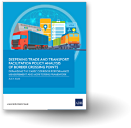Spotlight Archives
- ADB Working Paper Series on Regional Economic Integration No. 94 - Strengthening the Financial System and Mobilizing Savings to Support More Balanced Growth in ASEAN+3March 2012A. Noy Siackhachanh reviews the progress that has been made under the Asian Bond Market Initiative (ABMI) to date, and proposes additional measures to further improve the region’s savings-investment imbalances. Read more. View other working papers.
- Pacific Economic Monitor March 2012This edition of the Pacific Economic Monitor discusses 2012 and 2013 GDP growth and inflation projections for ADB's Pacific developing member countries. Read more
- FTA initiatives of Asia and the Pacific now total 250 22 February 2012Free trade agreements (FTAs) continue to grow rapidly in the Asia and the Pacific region. From just 53 in 2000, there were 250 FTAs as of January 2012, according to the Asian Development Bank. About half are concluded, with 64 under negotiation and 60 under discussion. Track FTA trends.
- ADB Working Paper Series on Regional Economic Integration No. 93 - Assessing the Resilience of ASEAN Banking Systems: The Case of the PhilippinesFebruary 2012This paper uses a macroprudential perspective to assess the resilience of banking systems in Association of Southeast Asian Nations. In particular, Jose Ramon Albert and Thiam Hee Ng use a vector autoregression model to conduct a stress test on the Philippine banking system. The estimated impact of macroeconomic shocks on nonperforming loan and capital adequacy ratios of the banking system is found to be generally minimal. However, the banking system do have some vulnerability to interest rate and stock market shocks. Read more.
- ADB Working Paper Series on Regional Economic Integration No. 92 - The PRC's Free Trade Agreements with ASEAN, Japan, and the Republic of Korea: A Comparative AnalysisJanuary 2012The People’s Republic of China (PRC) stands to reap sizable gains from entering into free trade agreements (FTAs) with its neighbors. The authors qualitatively and quantitatively analyze the four main permutations of the PRC’s FTAs with the region’s major economies: PRC–ASEAN, PRC–Japan, PRC–Republic of Korea, and ASEAN+3. Their comparative analysis reveals that the PRC would gain from all three bilateral FTAs, while gaining the most from a larger region-wide FTA such as ASEAN+3. Read more.
- ADB Working Paper Series on Regional Economic Integration No. 91 - Is Trade in Asia Really Integrating?January 2012When trade interdependence between countries is low, they tend to sign a shallow goods-centered agreement to boost trade between them. In contrast, when a high level of trade interdependence is already achieved and the economic interdependence structure between them is complex, a deep agreement that formalizes economic relations is required to avoid ad hoc political bargaining. Shintaro Hamanaka notes that this difference is the key to understanding the rationale of the noodle bowl of FTAs in Asia. Read more.
- ADB Working Paper Series on Regional Economic Integration No. 90 - Intra-Asia Exchange Rate Volatility and Intra-Asia Trade: Evidence by Type of GoodsDecember 2011Hsiao Chink Tang examines the impact of intra-Asia exchange rate volatility on intra-Asia trade in primary goods, intermediate goods, equipment goods, and consumption goods from 1980 to 2009. For Asia, the evidence shows that as intraregional exchange rate volatility increases, intraregional exports in all these goods fall. This adverse impact is even more pronounced in the sub-region of Association of Southeast Asian Nations (ASEAN)+5 (the People’s Republic of China; Hong Kong, China; Japan; the Republic of Korea; and Taipei,China) and especially among intermediate and equipment exports. These results have useful policy implications on the maintenance of exchange rate stability in the region. Read more.
- Aid for Trade in the Asia-Pacific: Its Role in Trade-Driven Growth, Report from the Co-Chairs of the Regional Technical Group (RTG) on Aid for Trade for the Asia-Pacific (2012)2012This first RTG Co-chairs report takes stock of the Asia-Pacific experience and identifies the way forward for the WTO Aid for Trade Initiative in the region. Aid for Trade offers the opportunity to close the gap between the two faces of the region. Download.
- Pacific Economic Monitor - December 2011December 2011This edition of the Pacific Economic Monitor examines 2011 budget outcomes and 2012 budget plans in ADB's Pacific developing member countries. Download the report.
- Asia Economic Monitor December 20111 December 2011Economic growth in emerging East Asia will continue to moderate to 7.2% in 2012 from 7.5% in 2011—as growing sovereign debt problems in Europe and an anemic US economy raise the spectre of a deep global economic downturn, says the Asian Development Bank’s latest Asia Economic Monitor. In the event that both the eurozone and the US economies contract sharply, the impact on emerging East Asia would be serious yet manageable, the report says. Download report and press release. Watch video and listen to the podcast.




